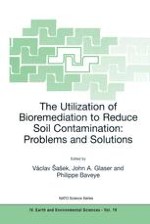2003 | OriginalPaper | Buchkapitel
Why Mycoremediations Have not yet Come into Practice
verfasst von : V. Šašek
Erschienen in: The Utilization of Bioremediation to Reduce Soil Contamination: Problems and Solutions
Verlag: Springer Netherlands
Enthalten in: Professional Book Archive
Aktivieren Sie unsere intelligente Suche, um passende Fachinhalte oder Patente zu finden.
Wählen Sie Textabschnitte aus um mit Künstlicher Intelligenz passenden Patente zu finden. powered by
Markieren Sie Textabschnitte, um KI-gestützt weitere passende Inhalte zu finden. powered by
Application of fungal technology (mycoremediation) for the cleanup of polluted soils holds promise since 1985 when the white rot fungus Phanerochaete chrysosporium was found to be able to metabolize a number of important environmental pollutants. This ability is generally attributed to the lignin-degrading enzymic system of the fungus. A similar degrading capability was later described with other white-rot fungal species. Most of the experiments were performed using liquid culture media. In soil conditions, where besides the fungus-degrading capability also other factors affect the process, our knowledge is rather limited. Many of the factors are similar to those generally influencing any soil bioremediation process (properties of the environmental matrix, bioavailability, temperature and other physical parameters, pollutant toxicity). Optimum performance of white rot fungal mycelium introduced into soil depends especially on its survival, colonization of the soil matrix and relation to autochthonous soil microflora. The development of fungal technology for decontamination of polluted soil has also been retarded by limited basic research knowledge; most of the results were obtained with the single fungal species Phanerochaete chrysosporium. However, the data were often generalized for all other white-rot fungal species without considering their physiological and ecological diversity. The goal of the presentation is the evaluation of the above aspects influencing the development of mycoremediation.
